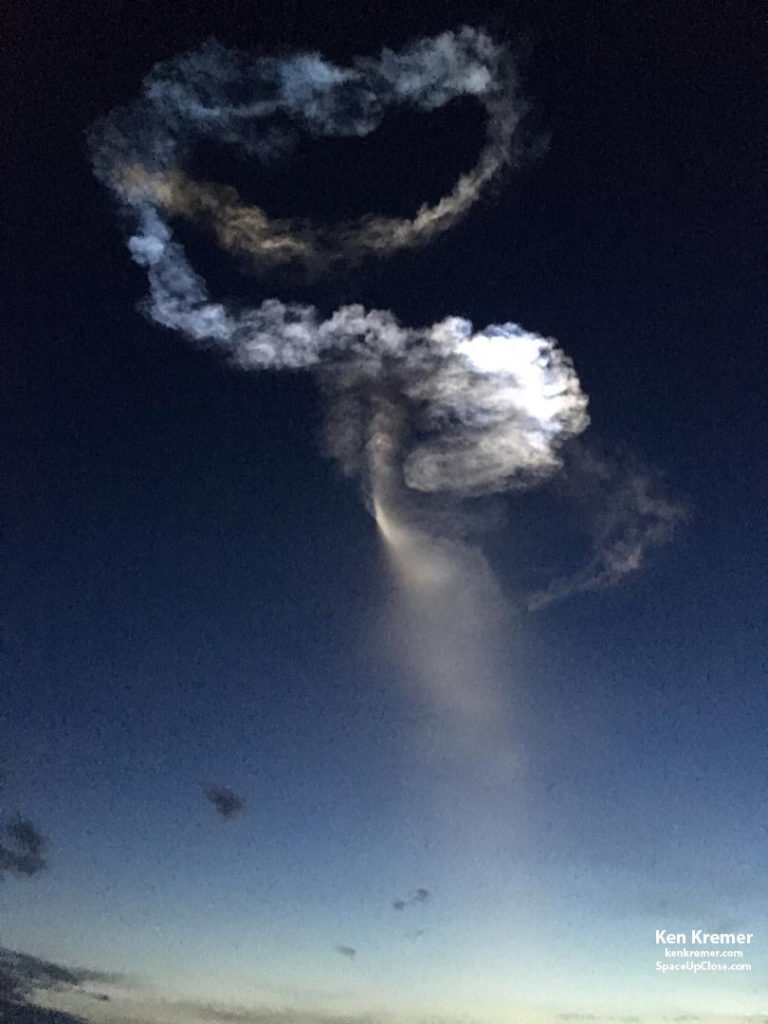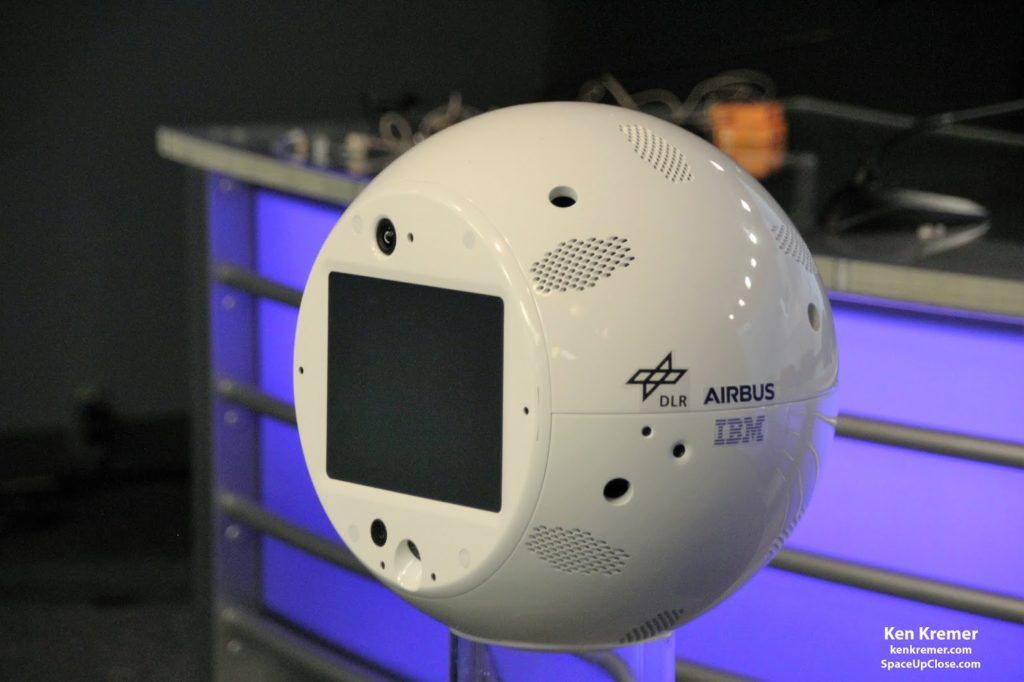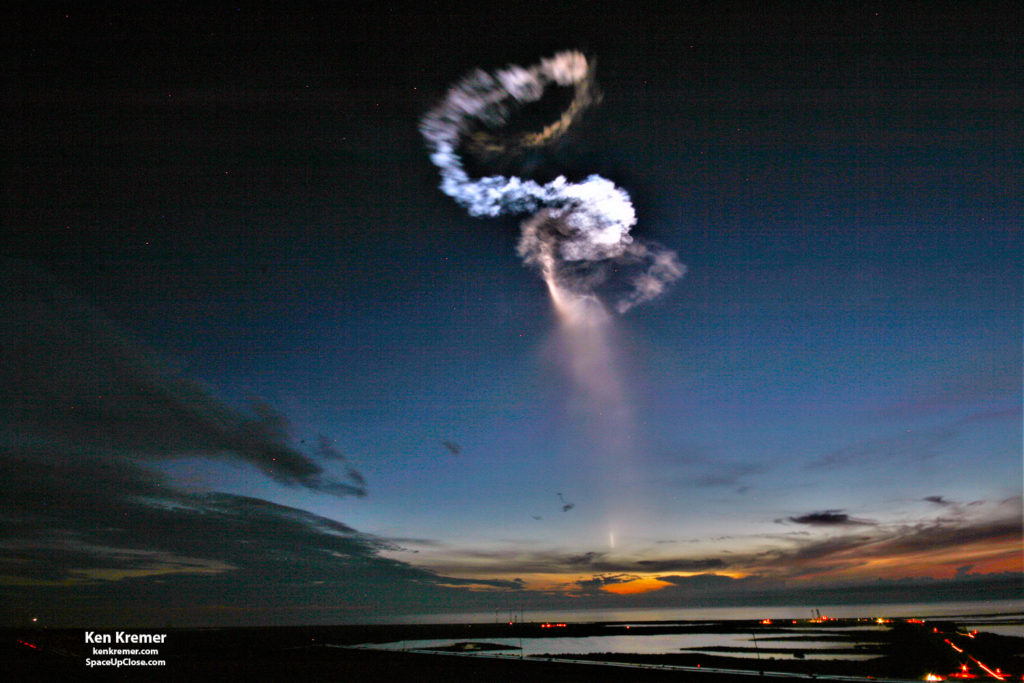 |
|
Long exposure streak shot of spectacularly
beautiful and successful launch of SpaceX Falcon 9 rocket before
dawn at 5:42 a.m. on June 29, 2018 from Space Launch Complex-40 on Cape
Canaveral Air Force, as it arcs over and disappears near the horizon on the way
to orbit. It is carrying the Dragon CRS-15 cargo ship loaded
with 3 tons of science for NASA to the ISS. Captured from the roof of NASA’s iconic VAB
at the Kennedy Space Center. Credit:
Ken Kremer/kenkremer.com/spaceupclose.com
|
Ken Kremer — SpaceUpClose.com — 30 June 2018
KENNEDY SPACE
CENTER, FL – A fabulous looking ‘space
jellyfish’ flooded the Florida Space Coast twilight skies early Friday morning –
created as a by-product of the SpaceX Falcon 9 rocket soaring off the Cape
launch pad bound for the International Space Station on a resupply mission for
NASA.
The recycled
SpaceX Falcon 9 rocket blasted off from Florida’s Spaceport June 29 and put on an
absolutely stunning sky show in the first minutes of its critical mission
carrying nearly 6000 pounds of research and gear aboard a SpaceX Dragon
spacecraft for NASA.
Check out our expanding
Space UpClose gallery of photos from myself and space journalist colleagues. Click
back as the gallery grows.
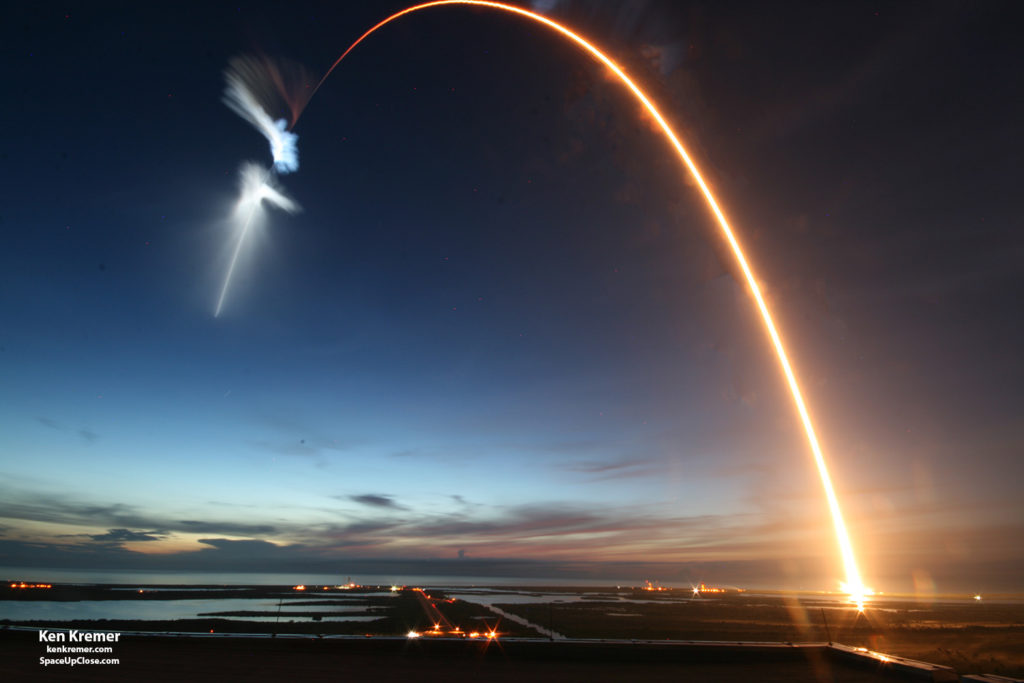 |
|
Long exposure streak shot of spectacularly
beautiful and successful launch of SpaceX Falcon 9 rocket before
dawn at 5:42 a.m. on June 29, 2018 from Space Launch Complex-40 on Cape
Canaveral Air Force. It is carrying the Dragon CRS-15 cargo ship loaded
with 3 tons of science for NASA to the ISS – captured
from roof of NASA’s iconic VAB at the Kennedy Space Center. Credit: Ken
Kremer/kenkremer.com/spaceupclose.com
|
The reused SpaceX Falcon 9 and recycled Dragon CRS-15
commercial cargo freighter lifted off into nearly cloudy free pristine twilight
skies precisely on time Friday June 29 at 5:42 a.m. EDT (0942 GMT) from seaside Space Launch Complex-40 (SLC-40)
at Cape Canaveral Air Force Station in Florida.
The phenomena that
created the ‘space jellyfish’ is known as the twilight phenomena.
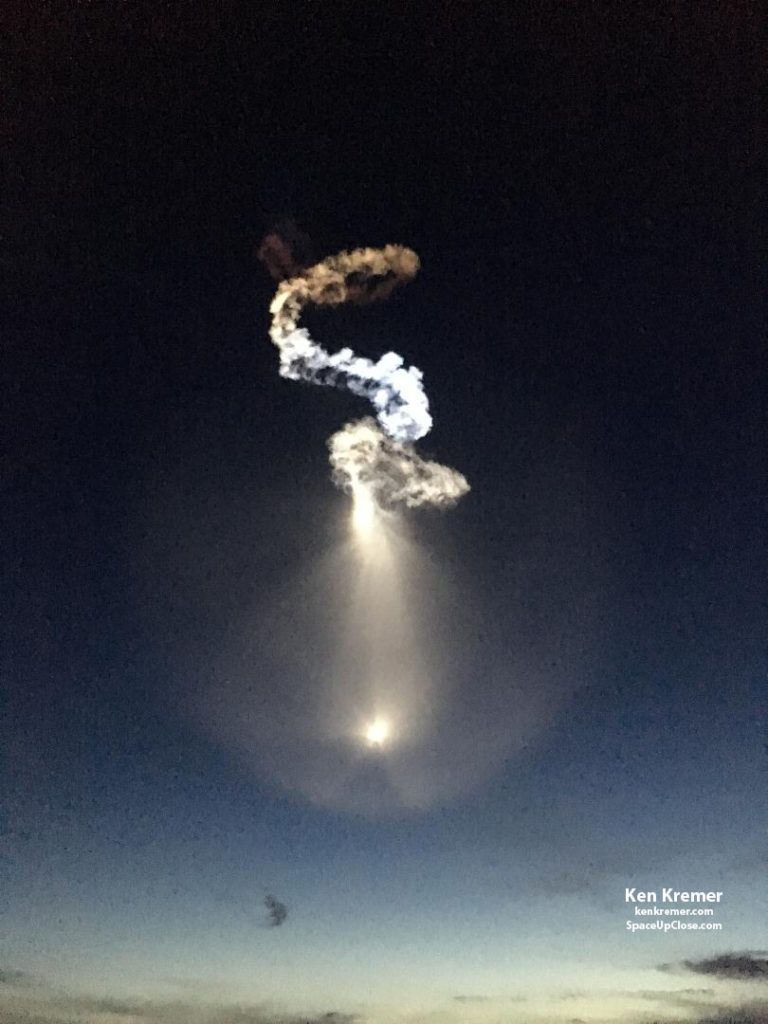 |
|
Spectacular ‘Space Jellyfish’
like exhaust plume from the June 29, 2018 predawn launch of SpaceX
Falcon 9 in the first minutes
after liftoff Space Launch Complex 40 at Cape Canaveral Air Force Station in
Florida at 5:42 a.m. EDT on Dragon CRS-15 cargo
delivery run for NASA to the ISS. Credit:
Ken Kremer/kenkremer.com/spaceupclose.com
|
As the 2 stage
rocket rose to the heavens sunlight glistened on the expanding exhaust plume
creating a giant moving jellyfish-like figure bathed in a mesmerizing and spectacularly
wide range of pastel colors painting the heavens above NASA’s Kennedy Space
Center in Florida as it moved through the skies in the first minutes after
liftoff, arcing over on a northeasterly trajectory as it accelerated skywards delivering
the Dragon CRS-15 cargo freighter to low Earth orbit.
The sun is
illuminating the exhaust plume from the rocket rising to space in this case
creating a ‘space jellyfish.’
“These pre-sunrise or post-sunset launches give for a
spectacular show in the sky,” Jessica Jensen, director of Dragon mission
management for SpaceX, said at the CRS-15 briefing for reporters at the Kennedy
Space Center.
“Basically, what’s happening
is, it’s still dark outside, but you have the sun illuminating the plume as
it’s in space. I like to refer to it as the ‘space jellyfish’ that’s coming
down after us.”
Many observers
including myself felt this was one of the most beautiful and psychedelic
looking launches ever from the Cape.
This was the 15th SpaceX resupply mission
launched to
the International Space Station under the original Commercial Resupply
Services contract (CRS-1) with NASA.
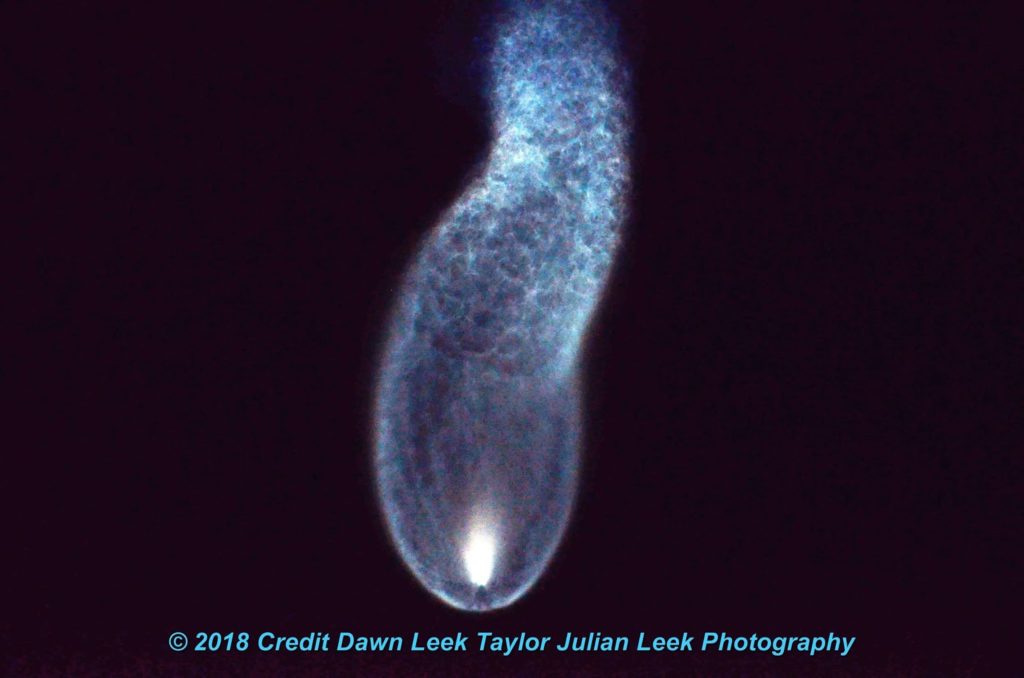 |
|
Launch of SpaceX Falcon 9 on Dragon CRS-15 mission on June
29, 2018 from pad 40 on Cape Canaveral, FL that created giant ‘space jellyfish’
over the Space Coast after liftoff. Credit: Dawn Leek Taylor
|
The Dragon CRS-15 spacecraft is scheduled to arrive at the
ISS Monday morning, July 2.
NASA TV will broadcast live coverage of the arrival with
capture by the Canadian built robotic arm expected around 7 a.m. EDT.
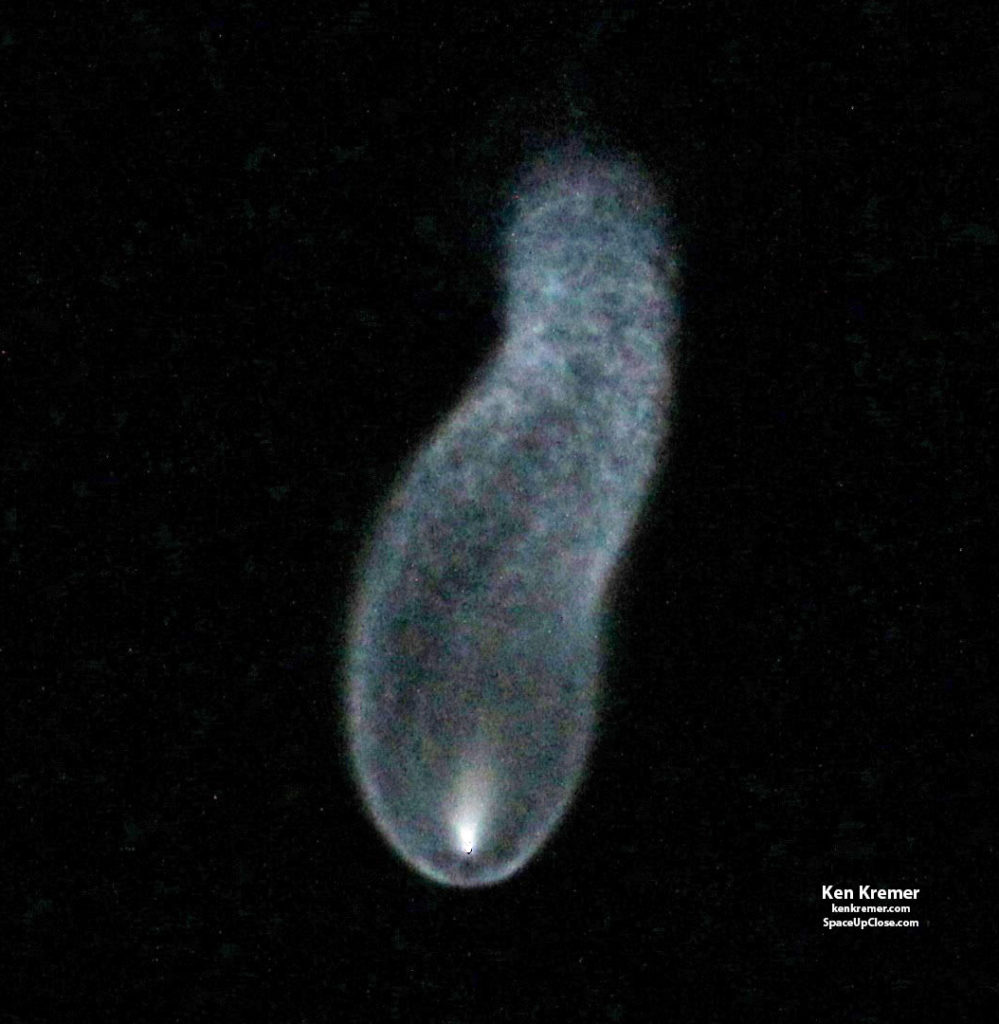 |
|
Giant ‘space jellyfish’ exhaust plume created over the Florida
Space Coast skies after launch of SpaceX Falcon 9 rocket before
dawn at 5:42 a.m. on June 29, 2018 from Space Launch Complex-40 on Cape
Canaveral Air Force. Credit: Ken Kremer/kenkremer.com/spaceupclose.com
|
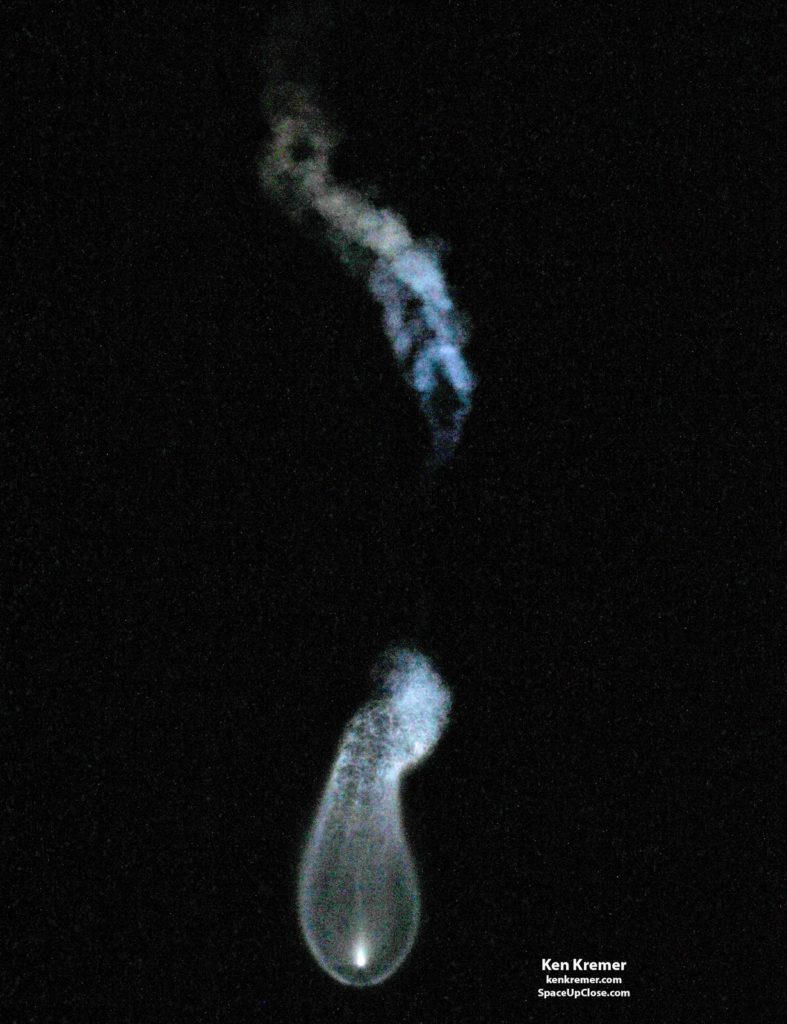 |
|
Giant ‘space jellyfish’ exhaust plume created over the Florida
Space Coast skies after launch of SpaceX Falcon 9 rocket before
dawn at 5:42 a.m. on June 29, 2018 from Space Launch Complex-40 on Cape
Canaveral Air Force. Credit: Ken Kremer/kenkremer.com/spaceupclose.com
|
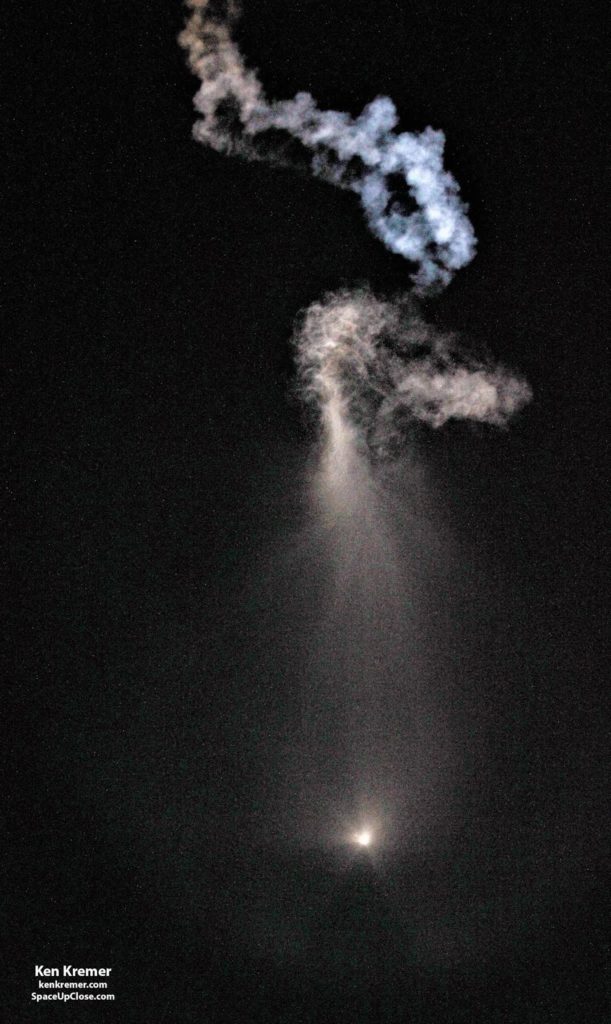 |
|
Credit: Ken Kremer/kenkremer.com/spaceupclose.com
|
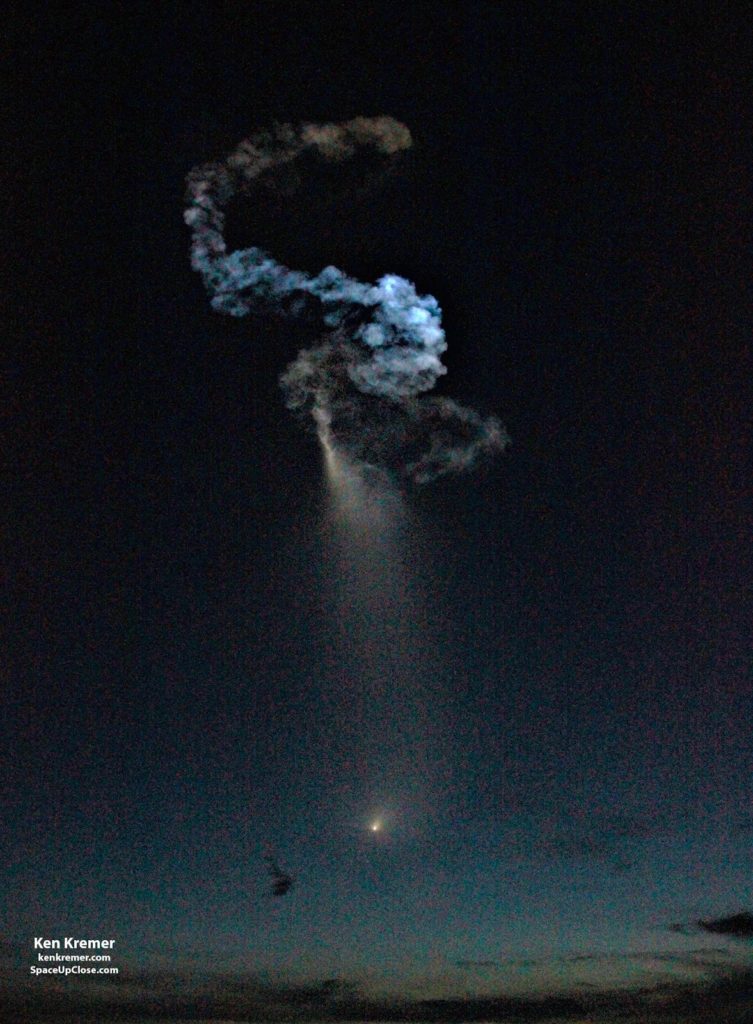 |
|
Giant ‘space jellyfish’ exhaust plume created over the Florida
Space Coast skies after launch of SpaceX Falcon 9 rocket before
dawn at 5:42 a.m. on June 29, 2018 from Space Launch Complex-40 on Cape
Canaveral Air Force. Credit: Ken Kremer/kenkremer.com/spaceupclose.com
|
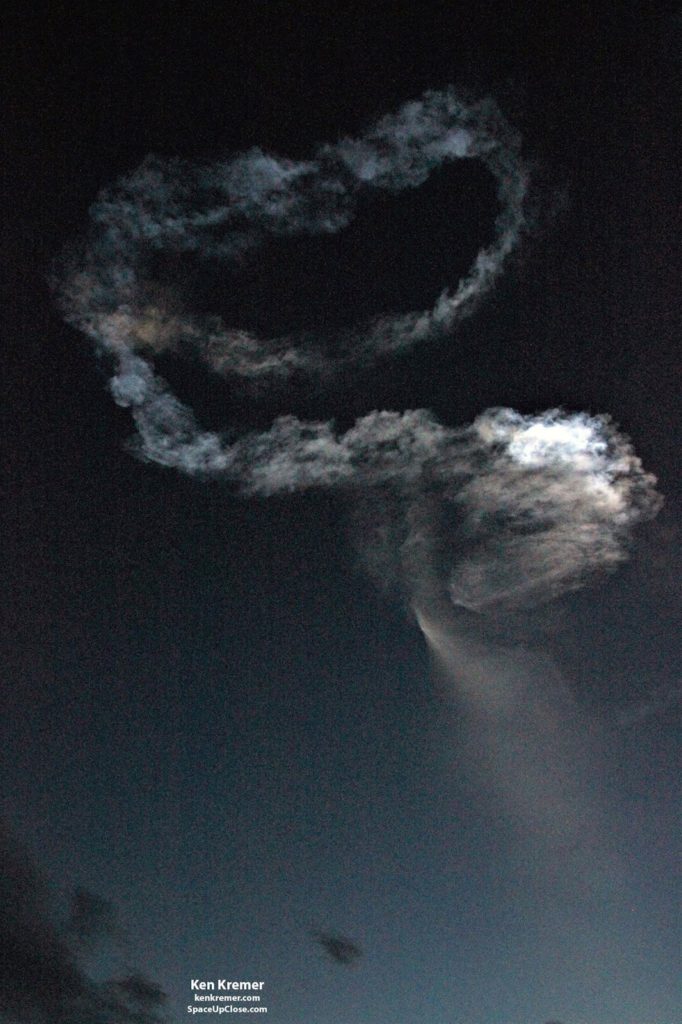 |
|
Credit: Ken Kremer/kenkremer.com/spaceupclose.com
|
Read our detailed articles about the mission.
Among the cargo is the
AI artificial intelligence imbued free
flying robot named CIMON provided by the German Aerospace Center (DLR), the
ECOSTRESS water monitoring platform from JPL, cancer and human health research
experiments and a new hand for the Canadian built robotic arm.
CRS-15 marks the 12th flight overall for SpaceX
in 2018 and the 2nd ISS resupply mission for NASA in 2018.
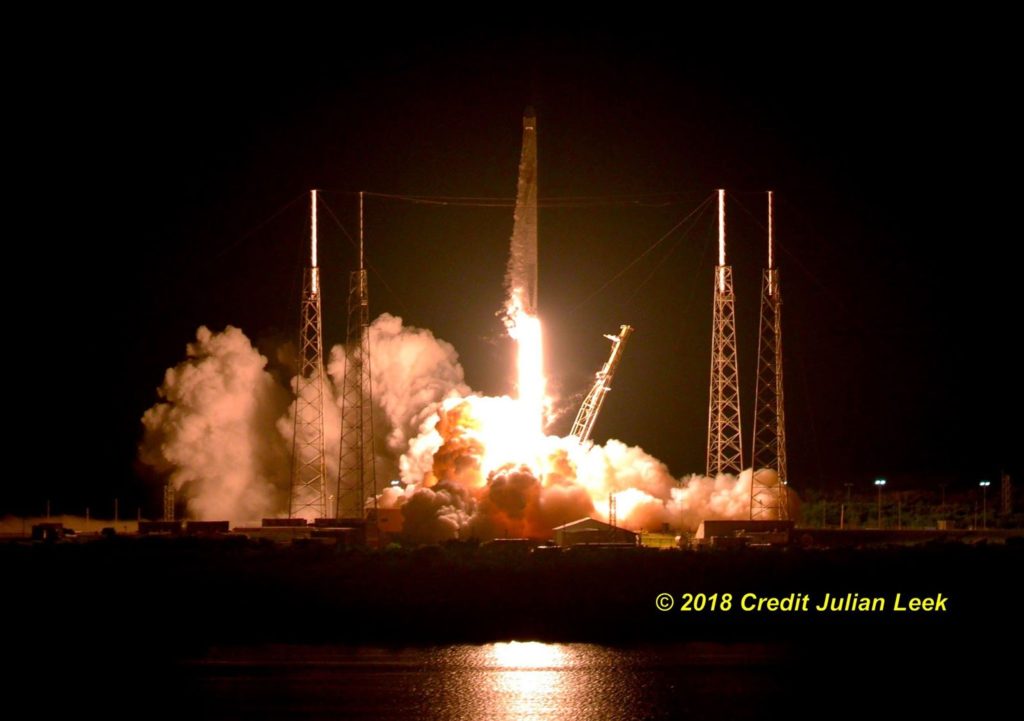 |
|
Launch of SpaceX Falcon 9 on
Dragon CRS-15 mission on June 29, 2018 from pad 40 on Cape Canaveral, FL. Credit: Julian Leek
|
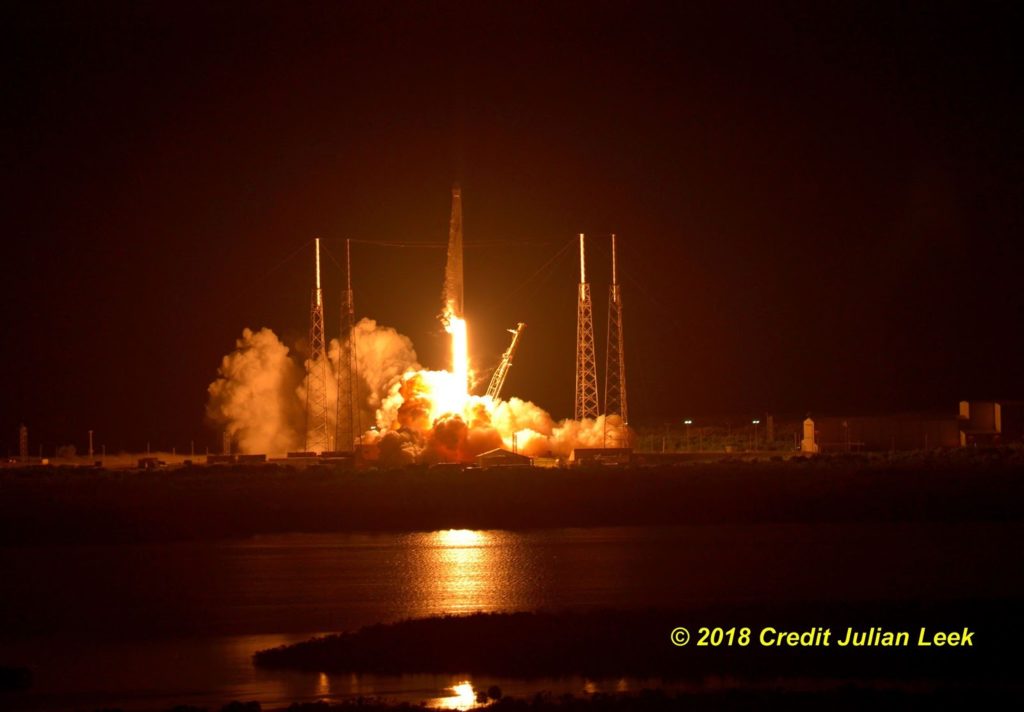 |
|
Launch of SpaceX Falcon 9 on
Dragon CRS-15 mission on June 29, 2018 from pad 40 on Cape Canaveral, FL. Credit: Julian Leek
|
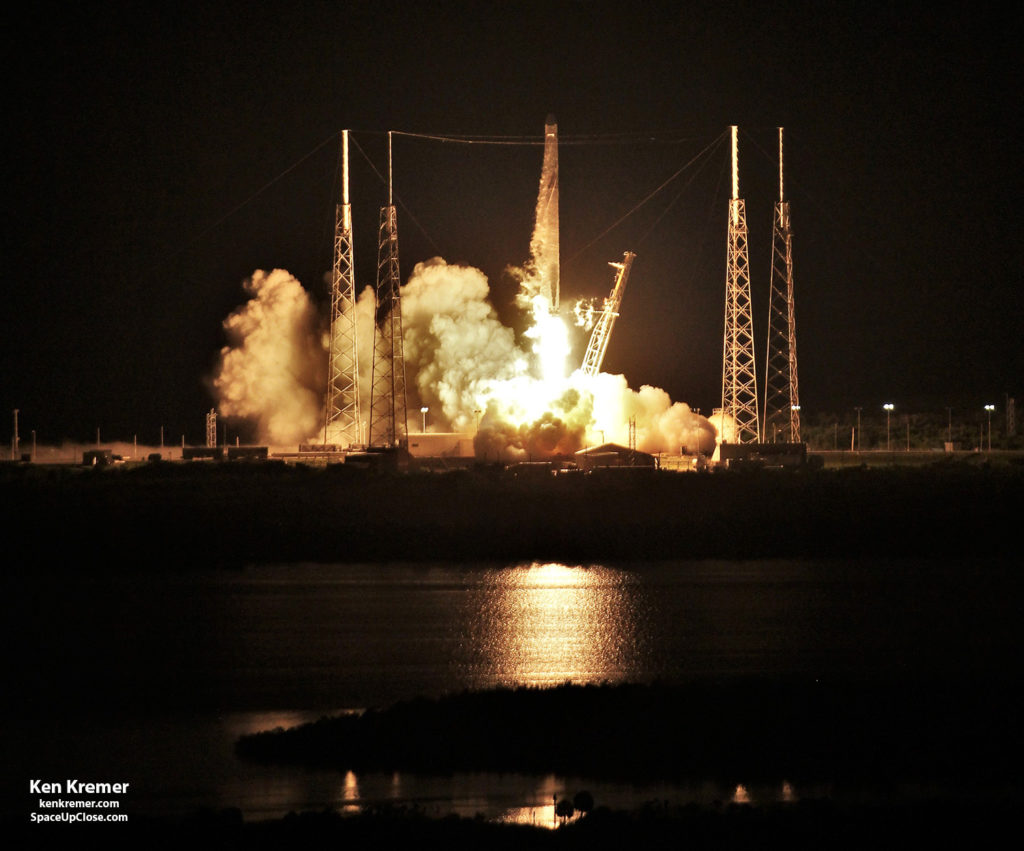 |
|
SpaceX Falcon 9 launch from Space Launch Complex 40 at Cape Canaveral Air
Force Station in Florida at 5:42 a.m. EDT on Dragon CRS-15 cargo delivery run for NASA to the ISS. Credit: Ken Kremer/kenkremer.com/spaceupclose.com
|
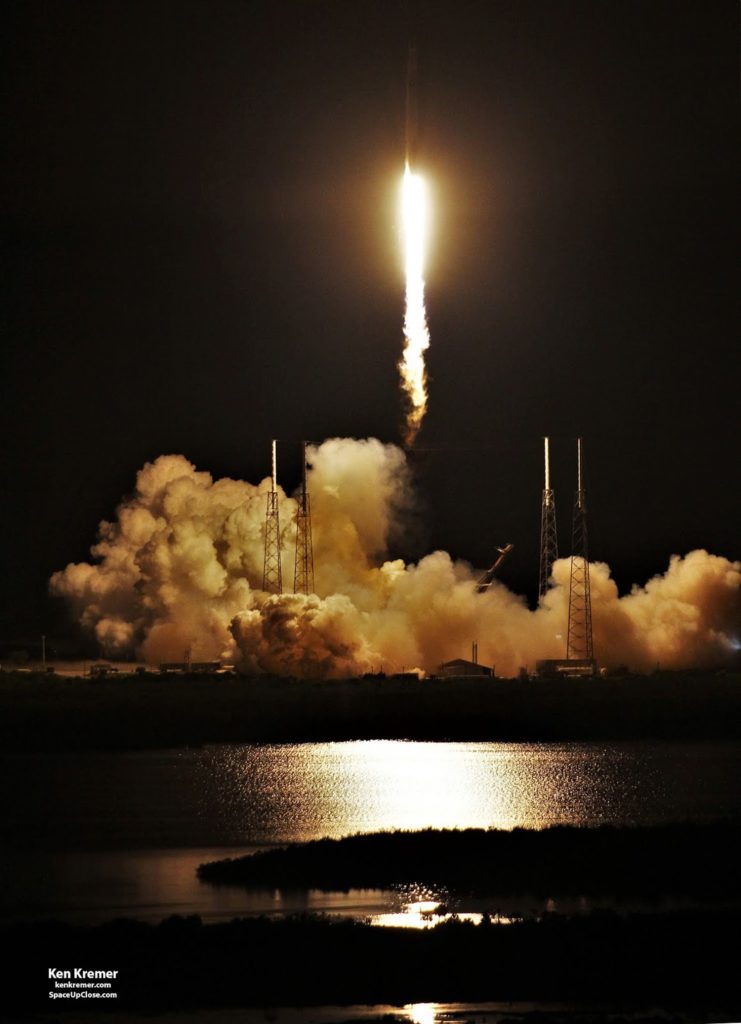 |
|
SpaceX Falcon 9 launch from Space Launch Complex 40 at Cape Canaveral Air
Force Station in Florida at 5:42 a.m. EDT on Dragon CRS-15 cargo delivery run for NASA to the ISS. Credit: Ken Kremer/kenkremer.com/spaceupclose.com
|
Watch for Ken’s continuing onsite coverage of NASA, SpaceX, ULA,
Boeing, Lockheed Martin, Orbital ATK and more space and mission reports direct
from the Kennedy Space Center, Cape Canaveral Air Force Station, Florida and
Wallops Flight Facility, Virginia.
Stay tuned here for Ken’s continuing Earth and Planetary science and human
spaceflight news: www.kenkremer.com
–www.spaceupclose.com – twitter @ken_kremer – email: ken at kenkremer.com
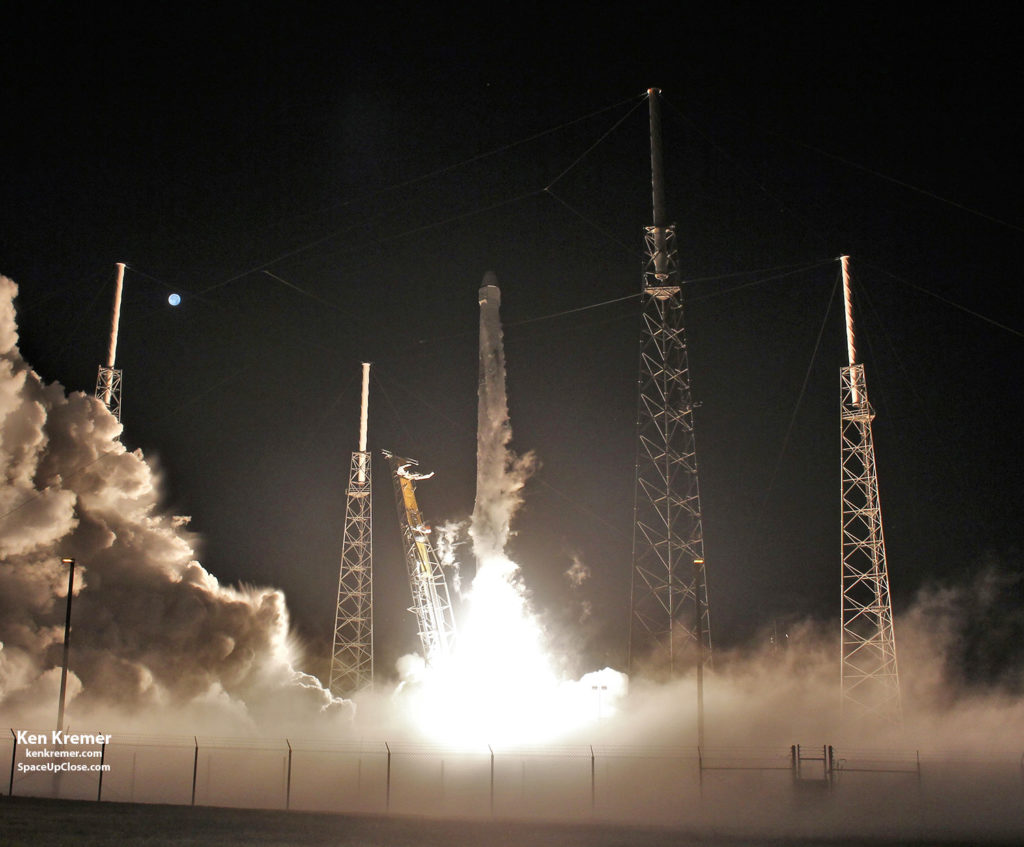 |
|
Falcon 9 flies past 98.5%
illuminated Moon after launching Dragon cargo craft from Space Launch Complex 40 at Cape Canaveral
Air Force Station in Florida at 5:42 a.m. EDT June
29, 2018. Dragon dazzles with CRS-15
cargo ship delivering 3 tons of
science & CIMON AI
astronaut assistant to International Space Station by SpaceX for NASA. Eerie
LOX cloud spreads out and envelopes pad surface. From my remote camera at pad
40. Credit: Ken
Kremer/kenkremer.com/spaceupclose.com
|
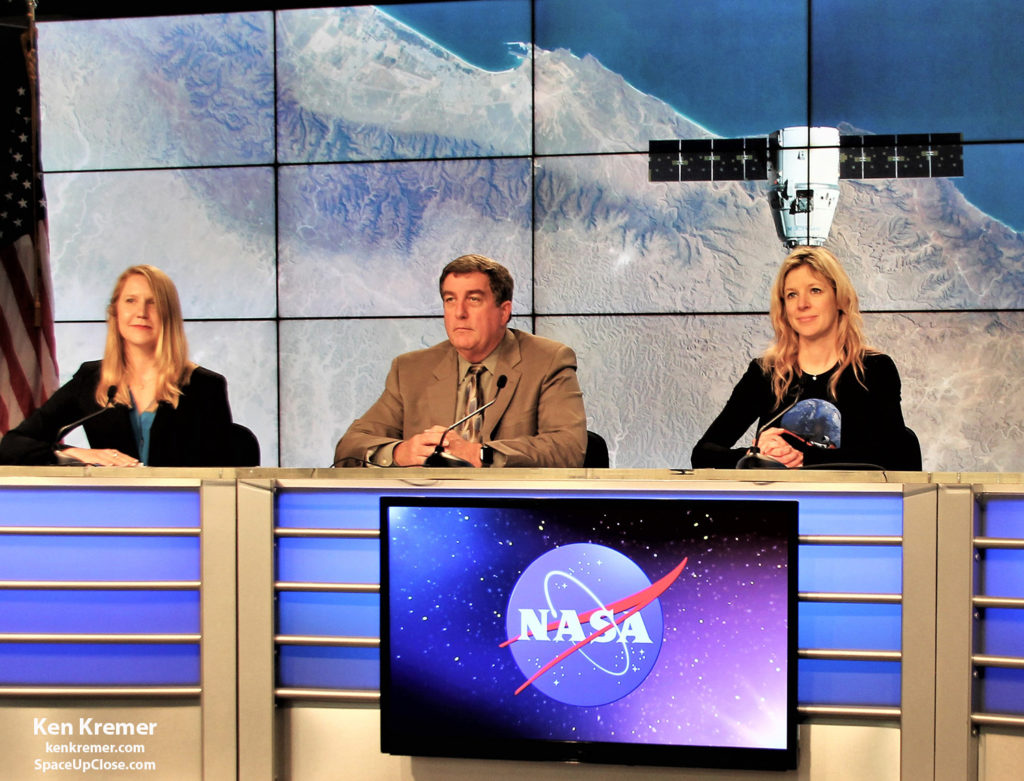 |
|
Post launch briefing for SpaceX
Falcon 9 Dragon CRS-15 mission at NASA Kennedy Space Center press site on
June 28, 2018 with Kirk Shireman, NASA ISS Program manager, Jessica Jensen,
SpaceX Dragon mission development director, and NASA PAO Stephanie
Schierholz. Credit: Ken Kremer/kenkremer.com/spaceupclose.com
|
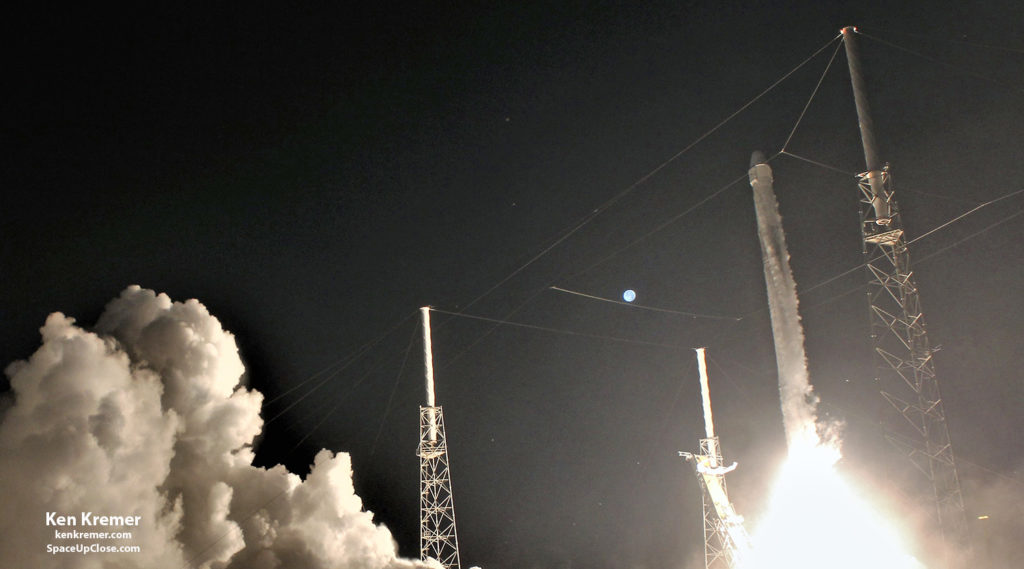 |
|
Falcon 9 flies past 98.5%
illuminated Moon after launching Dragon cargo craft from Space Launch Complex 40 at Cape Canaveral
Air Force Station in Florida at 5:42 a.m. EDT June
29, 2018. Dragon dazzles with CRS-15
cargo ship delivering 3 tons of
science & CIMON AI
astronaut assistant to International Space Station by SpaceX for NASA. Eerie
LOX cloud spreads out and envelopes pad surface. From my remote camera at pad
40. Credit: Ken
Kremer/kenkremer.com/spaceupclose.com
|













